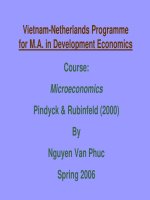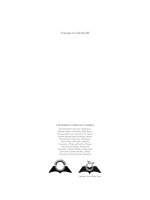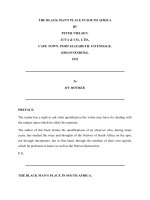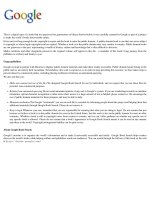Micro-Finance in Rural Communities in Southern Africa pdf
Bạn đang xem bản rút gọn của tài liệu. Xem và tải ngay bản đầy đủ của tài liệu tại đây (839.46 KB, 175 trang )
Micro-Finance in Rural Communities
in Southern Africa
PREPARED FOR THE INTEGRATED RURAL DEVELOPMENT PROGRAM OF THE
W.K. KELLOGG FOUNDATION, SOUTHERN AFRICA BY
THE HUMAN SCIENCES RESEARCH COUNCIL, PRETORIA
Country and Pilot Site Case Studies, Policy Issues
and Recommendations
Free download from www.hsrc
p
ress.ac.za
Photo Credits
pp 1, 24 – Ellen Elmendorp
pp 20, 26 – Paul Weinberg (South Photographs)
pp 76, 142 – Motlhalefi Mahlabe (South Photographs)
Cover by Paul Weinberg
DTP and Design by Charlene Bate
Produced by Compress in 2002
Free download from www.hsrc
p
ress.ac.za
Contents
Executive Summary
________________________________________________________
1
Chapter 1: Introduction
____________________________________________________
23
Chapter 2: Determinants of Demand for Financial Services in Three Pilot Studies
_____
29
Chapter 3: Access to Financial Services
_______________________________________
79
Chapter 4: Micro-Finance in Rural Communities
________________________________
127
Chapter 5: Policy Issues and Recommendations
_________________________________
145
References
________________________________________________________________
169
Appendix
_________________________________________________________________
173
Free download from www.hsrc
p
ress.ac.za
Glossary
ACAT African Co-operative Action Trust
ADAF Agricultural Development Assistance Fund
AFC Agricultural Finance Corporation of Zimbabwe
AFRACA African Rural & Agricultural Credit Association
AGRITEX Agricultural Technical & Extension Services
BAAC Bank for Agriculture & Agricultural Co-operatives
CAP Credit Against Poverty
CARE Concerned Americans for Relief Everywhere
ITDG Intermediate Technology Development Gap
CASS Centre for Applied Social Studies, University of Zimbabwe
CBZ Commercial Bank Of Zimbabwe
CCDR Corperativa de Credito para o Desenvolvimento Rural
CCM Conselho Cristao de Mocambique
CGAP Consultative Group to Assist the Poorest
CSO Central Statistical Office
DGRV Deutscher Genossenschaft und Raiffeisen Verband
FCPL Food Consumption Poverty Line
FPL Food Poverty Line
FRELIMO Frente de Libertaçao de Moçambique
GB Grameen Bank
GMB Grain Marketing Board
GTZ (ISTARN) Gesellschaft fur Technisches Zusammenarbeit (German Development
Corporation) (Informal Sector Training and Resource Network)
IDDP Initiative for Integrated District Development Programme
IFAD International Fund for Agricultural Development
ILRP Inhambane Livelihood Recovery Programmes
IRDP Integrated Rural Development Programme
LSM Living Standards Measurement
MDC Movement for Democratic Change
Free download from www.hsrc
p
ress.ac.za
MFI Micro-Finance Institution
MFRC Micro-Finance Regulatory Council
MIS Management Information System
MMF Mozambican Micro-Finance Facility
MSE Micro and Small Enterprise
NASASA National Association of South Africa of Stokvel Associations
NGO Non-Governmental Organization
NHFC National Housing Finance Corporation
PARPA Plan for the Reduction of Absolute Poverty
POSB Post Office Savings Bank
PPPP Public Policy Promotion Programme
RDC Rural District Council
RENAMO Resistençia Nacional Moçambique
RDDC Rural District Development Council
ROSCA Protecting Savings and Credit Associations
SACCO Savings and Credit Co-Operative
SACI Specialized Agricultural Credit Institution
SAFIRE Southern Alliance for Indigenous Resources
SBP Sustainable Banking with the Poor
SDI Spatial Development Initiative
SME Small and Micro Enterprise
SMME Small, Medium & Micro Enterprise
SOCREMO Sociedade de Credito de Mocambique
TCPL Total Consumption Poverty Line
USAID United States Aid Agency
WKKF W.K. Kellogg Foundation
ZAMFI Zimbabwe Association of Micro-Finance Institutions
ZANU (PF) Zimbabwe African National Union
ZAPF Zimbabwe Agricultural Policy Framework
Free download from www.hsrc
p
ress.ac.za
Free download from www.hsrc
p
ress.ac.za
1
Executive Summary
INTRODUCTION
The Integrated Rural Development Program (IRDP) is a core initiative in
the W. K. Kellogg Foundation Africa portfolio of programmes, which aims
to reduce poverty and improve the quality of life of rural communities. A
component of this programme is to help capitalise locally based enterprise
development initiatives by stimulating the provision of and access to
micro-finance in rural areas. Three sites have been selected to pilot the
introduction of this and other IRDP activities. These are: Chimanimani
(Zimbabwe), Chimoio (Mozambique) and Nyandeni (South Africa). As
part of this initiative, the Human Sciences Research Council (HSRC)
based in Pretoria has conducted an evaluation in three key sites of the
IRDP to evaluate the implications of implementing a micro-finance
scheme in these areas.
While micro-finance in its various forms has helped to make loan capital
more accessible to low-income rural communities, much remains to be
done to increase its outreach, impact and sustainability. The essential
objective of this study is to make well-researched recommendations for
IRDP policy and strategy to enable the micro-finance agents that it will
shortly be appointing to maximize improvements in these key indicators
in the three pilot sites. Chapter 1 outlines the institutional context and
terms of reference of the report and briefly discusses its timeframe,
methodology, value and limitations.
Chapters 2 and 3 depict, on the one hand, the demand for financial
services in the three pilot sites and, on the other, access to micro-finance
in the respective communities.
Free download from www.hsrc
p
ress.ac.za
In Chapter 4 an account is given of the essential nature and capabilities of micro-
finance, of recent developments in this regard, of fundamental lessons from
international experience and of best practices in a rural context.
Chapter 5 identifies the key sets of policy issues facing, in the first instance, public policy
makers seeking to promote micro-finance development and, in the second,
donors/investors/wholesalers seeking to support individual micro-finance retailers. It
then applies the findings of Chapter 4 to the three on-the-ground pictures sketched out
in Chapters 2 and 3 to arrive at some initial and very tentative recommendations for
policy for the IRDP in the respective pilot sites.
STATUS QUO IN THE PILOT SITES
The demand for micro-finance in Chimanimani
Chimanimani has been affected by the prevailing political instability facing Zimbabwe
recently resulting in a difficult economic environment. This instability involves farm
resettlements or invasions, the rule of law increasingly under threat, violence and
political intimidation.
This has contributed to less formal employment being available throughout Zimbabwe,
which has further expanded the average size of households in areas such as
Chimanimani, as less migrant work has become available. Over 70% of the population of
Chimanimani (110 000 people) live in the communal areas, which have less potential for
commercial agricultural production and an increasing pressure on natural resources.
Economic activities
Chimanimani has extremely varied ecological and climatic conditions. The five agro-
ecological zones of Zimbabwe are present in the district, ranging from areas that receive
over 2000mm per annum in the Chimanimani mountains to areas that have dry, harsh
conditions, which receive less than 300mm per annum. This means that there is
extensive variability in agricultural potential and in natural resource endowments.
Essentially this means that the major diversity found in Chimanimani should be used by
Kellogg and the IDRP to test and refine different options for the variety of agro-
ecological zone present.
The district has a mixed economy with agriculture being the main economic activity.
Agriculture in the communal areas is primarily for subsistence. The District has a dual
agrarian system divided between commercial farms (48.5%) and small-scale farming
(subsistence) community (51.5%).
2
MICRO-FINANCE IN RURAL COMMUNITIES IN SOUTHERN AFRICA
Free download from www.hsrc
p
ress.ac.za
The area is rich in natural resources with a locational advantage in terms of private
sector partnerships and cross-border trade.
A recent study (June 2001) undertaken by TechnoServe, which was\designed to carry
out an assessment of Potential Economic Drivers for the district, details the most
attractive economic opportunities as:
■ Fresh fruit production
■ Fruit processing and
■ Tourism
■ Honey manufacturing
However, the government and non-governmental organisations’ intervention, which
includes income generating activities, has fallen short of exploiting such opportunities.
The contributing factors cited include lack of institutional capacity, poor infrastructure,
fragmented agricultural production with no value adding, the group focus that does not
consider entrepreneurial and management skills, as well as capital and market access.
Implications for micro-finance
■ Political and macroeconomic instability has reduced the availability of formal sector
jobs and increased reliance on the informal sector. This will have increased the
demand for micro-finance (credit and savings) but will also have increased the risk
of default on loans. Political instability is a particular problem in Manicaland, in
which the Opposition MDC party has strong support. Violence involving the military
and police was reported in Chimanimani as recently as mid-October.
■ Most rural households reside in the less fertile agricultural areas. They are
nevertheless still heavily dependent on agriculture for income, given the near
absence of social security payments, the declining contribution of remittances to
household income and the virtual collapse of arts and crafts trade as tourism has
evaporated with political instability. But the long period between cash outlays and
cash inflow in most sorts of farming makes agriculture difficult to finance with
micro-credit.
■ All of the economic activities identified as having greatest potential – fruit growing
and processing, tourism and honey production – offer opportunities, directly or
indirectly, to small enterprises who will be looking primarily to micro-finance to help
meet their capital needs.
3
EXECUTIVE SUMMARY
Free download from www.hsrc
p
ress.ac.za
■ Though little information on local household expenditure patterns has yet been
obtained, it can be expected that almost all spending will be for consumption.
Income, whether from earnings or from loans, used for this purpose in effect
constitutes a small entrepreneur’s/household’s working capital.
■ The rapid increase in the incidence of HIV/AIDS will also have increased the need
for access to micro-finance (again both credit and savings) in care-giving
households to help them maintain income streams and reduce the pressure to sell
assets. But, again, it will have raised the risk of default as well as raising the number
of households beyond the ambit of sustainable micro-credit.
■ Most households continue to use formal sector savings facilities. Given the distance
and the cost of transport, there is an urgent need for improved informal sector
savings alternatives. The location of about 81% of households in rural areas
suggests that unit transactions costs will be high for micro-financiers
■ The multiple constraints on economic activity – political/macroeconomic
instability, poor infrastructure, low levels of business skills – indicate that, on its
own, improved access to micro-finance will have only a limited impact on poverty
reduction. An integrated range of interventions is needed for significant impact.
Access to Financial Services in Chimanimani
■ Access to credit for micro-enterprises in Chimanimani is very limited. The few
formal sector lending institutions that there are, either do not cater for clients
without adequate traditional collateral security or do so only for specific needs, such
as seasonal agricultural input requirements.
■ Informal sector lenders are reported to be few and, in general, small and weak. In
addition, such savings and credit associations as there are – whether co-operatives
(SACCOs) or rotating – are confined to lending only to their own members.
■ One registered micro-lender has now begun to operate in about half of the wards in
the district, but is also still very small, has yet to prove its viability and lends only to
women on a group basis.
■ Especially recalling the substantial and increasing demand for micro-loans from the
informal sector, there is an urgent need for a sustainable expansion of micro-
lending in Chimanimani.
■ There is also an urgent need for new, more widely distributed and more user-friendly
savings facilities – formal or informal. While meeting this need could be articulated
4
MICRO-FINANCE IN RURAL COMMUNITIES IN SOUTHERN AFRICA
Free download from www.hsrc
p
ress.ac.za
with responding to the demand for more micro-loan facilities, linking the two would
probably be the slower path and the less effective – particularly for advancing credit
■ A more enabling public policy framework – engineered jointly by regulatory
authorities, wholesalers/donors and retail micro-financiers – would be an
important step in accelerating the growth of sustainable MFIs.
The Demand for Micro-Finance in Chimoio
The rainfall pattern along with annual precipitation, humidity and fertile soils endows
the area with an important agricultural potential. Geographical and environmental
conditions are favourable for a high level of agro-forestry, animal husbandry, and
certain levels of tourism. During the raining season, however, the access to the
production areas becomes difficult, as the roads deteriorate quickly under heavy
rainfall. However, the mountainous areas along the Zimbabwean border are minimally
suitable for agriculture.
Mozambique experienced a civil war for over fifteen years, gaining a democratic
government in 1992. The fact that Mozambique has an elected government for the first
time in its history and has conducted two general elections, should not obscure the
threat posed by fault-lines in the political structures and power struggles between the
two main political parties.
Most ordinary Mozambiquans equated democracy with an improvement in material
conditions. Instead, the economic gains recorded thus far seem to benefit only a
relatively small middle class concentrated in Maputo, while the rest of the population
has had to adjust to increases in the cost of living and little change in the rudimentary
public and social infrastructure. This is partly due to the liberalisation of the economy,
fiscal discipline and the recent impact of flooding in the southern parts of the country.
The widening gap between rich and poor and rural and urban potentially poses a
serious threat to political stability. The prevailing state of poverty and rural-urban
inequalities is an important context to consider when evaluating any economic
development intervention.
This context was starkly emphasised during the recent devastation caused by flooding
in 1999 and 2000. For a country recovering from the debilitating effects of the civil war
coupled with devastating flooding, poverty has become the most pressing issue.
Illiteracy stands at about 60.4 percent of the adult population; and there is a shortage
of skilled labour and financial resources. According to the Ministry of Planning and
Finance, the incidence of absolute poverty is 69.4 percent, indicating that more than
two-thirds of the Mozambique population is living below the poverty line (2000). In
5
EXECUTIVE SUMMARY
Free download from www.hsrc
p
ress.ac.za
rural areas, it is estimated to be as high as 71.2 percent, an alarming figure as 80
percent of the population is concentrated into these areas. The figures for urban area
stand at 62 percent.
Economic activities
From the analysis around the financial needs of the average household in Manica and
from the information presented under the historical and political context it is clear that
most families utilise what can be termed a multiple livelihood strategy. This concept
essentially posits that a multiple livelihood strategy is dependent on people’s capacities
to generate and maintain their means of living, enhance their well being and that of
future generations. These capacities are contingent upon the availability and
accessibility of options which are ecological, economic and political.
People survive by building on a range of “capitals” be they land, livestock, skills,
knowledge, or natural resources. They include natural capital, such as the resource
base, in particular land and water; human capital, such as education, skills and health;
social capital, such as social networks, norms and organisations; physical capital, such
as farm equipment and shelter; and financial capital, such as income, credit, claims,
savings and cattle. These assets constitute the capital base of a livelihood and determine
how vulnerable or robust it may be. Poverty is strongly associated with a lack of assets,
or the inability to put assets to productive use.
It is clear that the informal sector is extremely important in Chimoio. The formal sector
is practically non-existent in Sussundenga, Gondola and Manica. Agriculture and
animal husbandry are extremely important components of the multiple livelihood
strategy in Chimoio although it should be emphasised that this on its own is
increasingly unable to provide a sufficient means of survival in rural areas of low-
income countries. Employment or agriculture should be considered as a component of
a livelihood, which draws upon a range of formal and informal activities and income
sources. Agricultural production in Manica province is, as emphasised earlier, largely
subsistence in nature. Agriculture does, however, have the potential to become a more
significant component of livelihood strategies considering the high agricultural
potential of the area considering the soils, climate and abundance of arable land.
Although some part of population in the district go to formal work in central business
district (CBD) in downtown, such as offices of governmental and non-governmental
organisations, banks, shops, hotel and rest-houses, and others institutions (private and
public enterprises), a large proportion depend of agriculture activities and informal
business.
6
MICRO-FINANCE IN RURAL COMMUNITIES IN SOUTHERN AFRICA
Free download from www.hsrc
p
ress.ac.za
The expenditure patterns evaluated indicate that the main financial needs per low-
income household pertain largely to consumer needs. The largest expenditure was for
groceries with annual expenditure at 12.76 percent overall. This was closely followed by
annual expenditure on cooking oil at 12.34 percent. Clothing was the third highest at
9.89 percent followed by entertainment at 8.66 percent and by meat and fish, the
dominant source of protein, at 8.41 percent. These indicate that the greatest
expenditure was on the basic commodities of food, clothing and on food processing.
Implications for micro-finance
■ While economic performance has improved substantially for the country as a whole
over the past decade, the benefits have been confined largely to urban areas and
even there to a relatively small part of the population. Widening income inequality
increases the potential for political instability. Interventions, such as improving
access to financial services, to broaden the spread of benefits to rural areas and to
lower income people are extremely important.
■ The location of about 85% of households in rural areas suggests that unit
transactions costs will be high for micro-financiers.
■ Farming is still by far the most important source of income for most households.
While the district has great potential to export agricultural produce, reliance on
local markets has increased with the damage to roads caused by the 1999-2000
floods.
■ A number of key formal sector industries – in textile and clothing manufacture,
tanning and food processing (jam, fruit juice, dairy products) – have closed in recent
years in the face of external competition, increasing reliance on agriculture and
informal sector activities.
■ There is a thriving informal sector, but it is based rather narrowly on retail trade in
consumption goods, agro-processing and services, such as repairs and hairdressing.
■ Very few small enterprises – almost all in the informal sector – have access to micro-
credit. Though the multiple constraints on the growth of economic activity – poor
infrastructure, lack of business skills, lack of institutional support – indicate that
micro-finance interventions on their own will only have a limited positive impact.
They are no less important on this account. What is needed is an integrated
programme of interventions, of which improved access to finance for ‘unbankable’
small entrepreneurs/households – through micro-credit – is a key component.
7
EXECUTIVE SUMMARY
Free download from www.hsrc
p
ress.ac.za
■ The rapid increase in the incidence of HIV/AIDS will also have increased the need
for access to micro-finance (again both credit and savings) in care-giving
households to help them maintain income streams and reduce the pressure to sell
assets. But, again, it will have raised the risk of default as well as raising the number
of households beyond the ambit of sustainable micro-credit.
■ Most households continue to use formal sector savings facilities. Given the distance
and the cost of transport, there is an urgent need for improved informal sector
savings alternatives. The location of about 81% of households in rural areas
suggests that unit transactions costs will be high for micro-financiers.
Access to Financial Services in Chimoio
■ Though data on a number of formal sector institutions that provide micro-finance
in Chimoio has still to be obtained, it is evident that very few micro-enterprises in the
district have been able to access micro-credit. Those formal sector MFIs that do
operate there tend to have quite specific, limited target markets which exclude many
categories of micro-enterprise. Especially given the growing reliance on informal
sector employment, there is an urgent need to broaden access to micro-finance.
■ Much more research is required to assess the extent of informal sector MFI activity.
But however extensive, access to credit can be expected to be confined to members
of relatively small savings groups.
■ Access to formal sector savings facilities is also limited, with banks operating
branches in only the largest urban centres. At this point, lack of adequate
information about informal sector MFIs prevents firm conclusions about the need
for additional micro-savings facilities.
■ The growth strategies adopted by the larger, better established MFIs suggest that the
industry as a whole is moving towards far greater outreach and sustainability. But
this is from a very low base and a great deal remains to be done to realize the
potential that is now being shown. In particular, institutional strength needs to be
gathered as a first priority, with less emphasis being placed at this stage on client and
product expansion.
■ Public policy needs to be reformulated, inter alia, to provide for the evolution of
MFIs into a wider, more flexible range of institutional forms than the present two
options – commercial bank or savings co-operative – and to incentivize MFI-private
sector partnerships.
8
MICRO-FINANCE IN RURAL COMMUNITIES IN SOUTHERN AFRICA
Free download from www.hsrc
p
ress.ac.za
The Demand for Micro-Finance in Nyandeni
The whole of the Nyandeni and Port St Johns region falls into the summer rainfall of the
Eastern Cape and precipitation is characterised by sharp heavy showers and high
variability. However, micro-climatic conditions in this region vary significantly, with
Port St John receiving much higher summer rainfalls than Nyandeni. This, together
with widely differing types of soils and vegetation and land can be placed under
irrigation (rain-fed). The agricultural productivity in this is poor and below average
although the natural fertility of the country forms part of the indigenous Wild Coast of
the eastern Cape. The whole of the Nyandeni region is susceptible to drought. Irrigation
farming offers the best opportunity for increasing productivity on the farms and for
diversifying crop production to include high value crops such as vegetables. Irrigation
farming offers an opportunity for increasing productivity on the farms and for
diversifying crop production to include high value crops such as vegetables.
Economic activities
Economic activities in this region depend to a large extent land resources, and therefore
major economic activities in Nyandeni and Port St’ Johns are land based economic
activities. There are no formal sector industries in this region and industries based on
rural land resources are almost non-existent in this region. The region has no formal
sector employment opportunities. The only employment opportunities are in various
government departments mainly in the teaching, nursing, police and administrative
services of various government department. Major sources of household income are old
age pension grants and other welfare social benefits, remittances from family members
working outside Nyandeni and Port St Johns areas; income from agricultural activities
and from many different informal sector survival strategies.
Implications for micro-finance
■ In common with Chimanimani and Chimoio, farming still predominates as an
economic activity, despite the unreliable rainfall. But in contrast with the other two
pilot sites, while taking up a large part of labour time, it accounts for a significant
proportion of household income only in a minority of cases. A recent report
concludes that ‘full-time farming does not seem to be the objective of most
households (who) aim at diversifying their sources of income. Today’s diversity
represents the background for tomorrow’s diversity and development programmes
should take this into account.’ (Peret, S et al., p32).
■ While social security payments make up an important part of many households’
income, active steps towards diversification have traditionally involved temporary
9
EXECUTIVE SUMMARY
Free download from www.hsrc
p
ress.ac.za
migration by household members to find wage employment. With the steady decline
in the number of formal sector jobs in recent years, the importance of
employment/self-employment in the local informal economy, though still small, has
begun to grow and, with it, the need for access to micro-finance by micro-
enterprises, who are usually seen as ‘unbankable’ by the formal banking sector.
■ The data available on the informal sector suggest the presence of a wide range of
micro-level agricultural, agro-processing, manufacturing and service activities,
almost all of which – including the most popular agricultural line, poultry
production – have cash flow patterns compatible with most micro-credit schemes.
■ Though the number and intensity of constraints on local economic development
are not as great as in Chimanimani and Chimoio, poor physical and institutional
infrastructure and lack of business skills will still limit the capacity of micro-finance
on its own to reduce poverty. For maximum impact, micro-finance initiatives need
to be complemented by programmes to deal with these other constraints.
■ Though little information on local household expenditure patterns has yet been
obtained, it can be expected that almost all spending will be for consumption.
Income, whether from earnings or from loans, used for this purpose in effect
constitutes a small entrepreneur’s/household’s working capital.
■ The rapid increase in the incidence of HIV/AIDS will also have increased the need
for access to micro-finance (again both credit and savings) in care-giving
households to help them maintain income streams and reduce the pressure to sell
assets. But, again, it will have raised the risk of default as well as raising the number
of households beyond the ambit of sustainable micro-credit.
■ Most households continue to use formal sector savings facilities. Given the distance
and the cost of transport, there is an urgent need for improved informal sector
savings alternatives. The location of about 81% of households in rural areas
suggests that unit transactions costs will be high for micro-financiers.
Access to Financial Services in Nyandeni
■ South Africa has a large, well established rapidly expanding micro-finance industry.
However, the centre of gravity of the industry is firmly in urban areas, in consumer
finance and in the salaried employee market.
■ Though as much as 35% of micro-finance activity is estimated to take place in rural
areas, the overwhelming bulk of it is through informal sector savings groups. Micro-
10
MICRO-FINANCE IN RURAL COMMUNITIES IN SOUTHERN AFRICA
Free download from www.hsrc
p
ress.ac.za
credit for rural households and micro-enterprises is much more difficult to access.
Even in the nearest city or large town, these categories of borrower – especially
micro-entrepreneurs – are not well catered for, as relatively few are regular salaried
employees and most micro-loans are geared to consumer needs. Very few NGOs that
offer financial services are located in rural areas. Coetzee concludes that unless
rural communities expand their own initiatives, access to micro-finance –
particularly micro-credit – can be expected in general to deteriorate rather than
improve in the foreseeable future.
■ Notable potential counterforces are the Land Bank, TEBA-Cash, in Kwazulu-Natal,
Ithala Bank, all of which are institutionally and financially strong and are committed
to operating in rural areas, and the village banking movement, which, though still
small, appears to be expanding on a sound basis after an indifferent start.
■ Only a very small percentage of micro-enterprises (urban or rural) use micro-credit
– estimated at no more than 1% currently. The main source of loans for micro-
enterprises is trade credit in some form and the purpose to which it is put is, as
expected, to fund working (as opposed to fixed) capital requirements. Almost no
start-up capital for micro-enterprises is borrowed from MFIs.
■ Though unemployment levels are high, especially in rural areas, most rural
households are able to draw on income from a range of sources. Locally earned
wages are on average the most important source, but remittances from household
members employed elsewhere and welfare payments (chiefly pensions and disability
grants) also contribute a substantial component. From recent surveys conducted in
KwaZulu-Natal and the Northern Province, it is evident that the average rural
household will generate no more than about 5% of its income from agriculture.
Significantly, domestic micro-enterprises bring in almost the same. (The Nyandeni
district is likely to be reasonably comparable to the Northern Province.) This
diversity of income sources adds greatly to rural households’ ability to cope with
income volatility and consequently to their creditworthiness.
■ The popularity of informal savings groups is explained by the long average distances
to formal sector savings facilities recorded in the same surveys – 30-80 km. While a
proportion of these savings is on-lent, it is almost always only to members of these
groups, either on demand or on a rotating basis. Much of the balance of the savings
is channelled through formal sector deposits away from the rural economy. Very few
formal sector bodies that offer rural savings facilities also engage in micro-lending in
rural areas – TEBA-Cash and, in KwaZulu-Natal, Ithala Bank being the main
exceptions.
11
EXECUTIVE SUMMARY
Free download from www.hsrc
p
ress.ac.za
■ The picture in Nyandeni does not appear to differ significantly from this
countrywide rural perspective. At present, no formal sector MFIs are recorded as
having branches in the district, although one NGO and one parastatal have provided
start-up and other grants for a range of informal sector employment projects and
assisted the projects in obtaining finance from other sources, such as the Land Bank.
One formal sector bank offering micro-credit is reported to be planning to open in
Libode.
■ However, just outside the district’s western border is Umtata where a broad range of
formal and informal micro-finance services is available. It can safely be assumed
that many Nyandeni residents make use of these facilities, though, as already noted,
not often for micro-enterprise finance.
POLICY ISSUES
The W.K. Kellogg Foundation’s (WKKF) Integrated Rural Development Programme
(IRDP) has a twofold interest in policy issues. The first arises directly from the
implementation of the programme in the nine chosen pilot sites, and the second
through the Public Policy Promotion Program (PPPP), soon to be launched as an
integral part of the IRDP. One of its key objectives is the improvement of public policy as
it impacts on rural development.
Chapter 5 focuses firstly on public policy on micro-finance promotion in Zimbabwe,
Mozambique and South Africa, which are the countries in which the three pilot sites for
the IRDP’s planned micro-finance initiative are located. It then moves on to
donor/investor/wholesaler policy for retailer support, in particular as it relates to the
three pilot sites.
Public Policy on Micro-finance
Zimbabwe
The essential stance of Zimbabwean government towards the micro-finance industry
has been positive. Various initiatives, such as an apex lending window for the industry,
have been undertaken. However, the fact that the industry has not expanded or
prospered as it should have over the last ten years can nevertheless be ascribed to a large
degree to public policy, as borne out by the following list of problems:
■ The Moneylender’s Act, which governs a large part of the industry, is outdated and
inadequate in a number of crucial respects, in particular in providing for effective
supervision of micro-finance institutions’ (MFIs’) operations and interest rate
ceilings that are compatible with current high inflation rates.
12
MICRO-FINANCE IN RURAL COMMUNITIES IN SOUTHERN AFRICA
Free download from www.hsrc
p
ress.ac.za
■ The requirements for micro-lenders to qualify to borrow from government’s apex
window seem to be too restrictive. In addition, loans have been available solely for
on-lending, whereas MFIs’ needs are often for loans for other valid purposes, such as
building their institutional capacity in preparation for expanded on-lending.
■ There is a lack of co-ordination between the various government support
programmes and, in particular, no single ministry responsible for MFI development.
The White Paper containing proposals to rationalize government support does not
seem to have been based on adequate consultation with the respective ministries
and programmes.
■ Different Acts, different forms of registration and different legal status apply to MFIs
that are all providing similar services. There is a need to develop a clear, coherent
policy framework, in consultation with all relevant stakeholders, within which all
MFIs operate.
■ Savings and credit co-operatives (SACCOs) can only lend to their own members, i.e.
those who have already established an adequate savings track record with them.
This way, accumulating capital to lend is slow and outreach is far too tightly
circumscribed to meet overall demand for micro-credit.
■ Most MFIs that are not registered SACCOs cannot make loans from savings
deposited with them. Since most are also unlikely to be able to borrow on
commercial money or capital markets, this large group of MFIs can therefore only
operate as savings vehicles, or have to rely heavily on donors for on-lending capital.
Since most savings made in rural areas through these MFIs are deposited in
commercial banks to earn interest, savings are channelled away from the areas
where they are most needed to capitalize micro-loans.
■ The revision of legislation governing the state’s agricultural banking arm,
AgriBank, and the subsequent restructuring of the bank to create the Agricultural
Development Assistance Fund (ADAF) to lend to small market-orientated farmers
using modified traditional agricultural lending instruments, has not enabled the
bank to reach the vast majority of small farming households, who produce mainly
for their own consumption. To reach these farmers effectively, ADAF will need to
enter the field of non-specific cash micro-lending, which may require further
amendments to legislation.
■ Fiscal and other incentives to the private sector to become more involved in micro-
lending have been lacking.
13
EXECUTIVE SUMMARY
Free download from www.hsrc
p
ress.ac.za
Dominating and dwarfing all these deficiencies in recent years have been political
policies that have brought turbulence and a deteriorating macro-economy. This has
created a problematic environment for any business to operate in – especially fledgling
industries such as micro-finance. The net result has been a dearth of financial
intermediaries capable of channelling state or donor capital injections widely but
sustainably to micro-enterprises, especially in rural areas.
This is a particularly difficult time in which to launch a new micro-finance initiative, but
also a particularly valuable one if it is able to succeed.
Mozambique
Although it is still small and weak, the MFI industry in Mozambique has made
important strides towards improving outreach and sustainability in the past few years.
Beyond the determination of most larger operators to become more market responsive
and to take on board the structures and systems needed to achieve this, developments in
state policy to promote MFI growth, though relatively few, have also assisted. Most
obvious areas for taking this process forward include:
■ More effective implementation of the 1998 requirement for all institutions and
individuals providing credit to register with the Bank of Mocambique (BoM).
■ The standardization of reporting requirements needs to be taken further and has
not been helped by slowness to register. Donors can play an important role to
enforce compliance in both respects in their selection of and support for MFI
retailers.
■ Most MFIs are still informal savings or savings and credit associations or are donor-
driven NGOs. The range of institutional forms into which such MFIs may evolve to
facilitate growth and sustainability is still very limited. The only two options
currently are: commercial bank – with minimum capital and reporting
requirements that are beyond the reach of most aspirant MFIs; and credit co-
operatives – which can only lend to members with adequate savings track records
and are consequently not attractive to most donors/investors/wholesalers.
■ Among the options missing are credit unions of the nature seen in most other
countries. Appropriate legislation, based on international best practice and
incorporating provisions to allow both corporate and mutual or co-operative share
structures, needs to be drafted in consultation with MFIs and other stakeholders.
■ Another important measure is to reinforce the BoM’s supervisory capacity.
14
MICRO-FINANCE IN RURAL COMMUNITIES IN SOUTHERN AFRICA
Free download from www.hsrc
p
ress.ac.za
South Africa
A recent study identifies eight important categories of measures needed to improve
SMMEs’ access to financial services. These are:
i) removing price barriers to lending that will stimulate investment in SMME lending,
e.g. allowing exemption from the Usury Act to apply to larger loans than at
present;
ii) improving market information, e.g. the wider operation of credit bureaux, better
collection of baseline statistics and more market research;
iii) developing more cost-effective debt recovery systems, inter alia, which require
fewer steps necessitating slow, expensive court action;
iv) increasing the attractiveness of the industry to venture capital, e.g. by offering tax
incentives;
v) expanding the use of “financial scorecards” to screen clients, especially start-ups,
by MFIs;
vi) creating a homogeneous government policy framework applying to MFI promotion
and regulation – several government departments and parastatals are currently
involved, each with their own approach;
vii) stimulating access to capital for non-bank financial intermediaries, e.g. by
facilitating the capitalization of savings and credit associations by donors/
investors/wholesalers; and
viii) promoting capacity building in SMMEs and MFIs.
All will need careful scrutiny to make sure that the interests of clients/members are not
compromised. Measures 1, 4 and 6 most clearly involve changes in public policy and
legislation, but almost all of the others – with the possible exception of 5 – seem to offer
scope for public intervention as well.
Donor/Investor/Wholesaler Policy for Retailer Support
Donor organizations around the world face very similar sets of unknowns and
policy/strategy decisions in their efforts to select and support micro-finance retailers. In
response, various sets of principles have been drawn up to crystallize and assist best
practice. The report draws heavily on a widely used statement of guidelines compiled by
the World Bank-related Consultative Group to Assist the Poorest (CGAP).
15
EXECUTIVE SUMMARY
Free download from www.hsrc
p
ress.ac.za
Though the need for diversity to address local circumstances is recognized, the
guidelines are based on the premise that fundamental principles of finance apply widely
and must be applied by all institutions if they are to succeed.
The framework for the guidelines is built around the two crucial, complementary
objectives: outreach and sustainability. It first identifies characteristics that donors
should seek in selecting institutions to support, then outlines appropriate forms of
support and concludes with some suggestions for reporting requirements.
Characteristics to guide MFI selection
The following defining characteristics are listed, which should be applied with discretion
where the micro-finance industry has not yet established itself on a firm footing, as is
arguably the case in Zimbabwe and Mozambique and, in certain respects, also in rural
South Africa.
■ Institutional strengths: culture, structures, capacities and operating systems to a
significant and growing number of low income clients; accurate and efficient
management information systems; operating methods that manage a high volume
of small transactions cost efficiently; and meaningful reporting standards to enable
effective monitoring.
■ Quality of services and outreach: evidence of focus on and commitment to
servicing low-income clients, particularly those with least access to other financial
services (rural people, especially women, youth and HIV/AIDS-support
households); client-appropriate lending (quick access to small loans for short
periods, escalating, if demanded, on track record and using non-traditional forms of
collateral); savings services, if possible; demonstrated growth of outreach,
especially once adequate institutional strength has been achieved.
■ Financial performance: appropriate pricing policies (interest rates able to cover full
costs of a mature MFI, including an acceptable return on equity, but no higher);
sound portfolio quality (arrears and defaults low enough not to threaten ongoing
viability); self-sufficiency (steadily reducing dependence on subsidies/donations,
first to cover full operating costs and eventually full capital costs); movement
towards complete financial independence (ability to raise full capital requirements
on commercial equity/capital/money markets). If MFIs are also tasked with
delivering training or business development services, the cost of the latter should be
excluded from assessing the financial performance of lending activities.
16
MICRO-FINANCE IN RURAL COMMUNITIES IN SOUTHERN AFRICA
Free download from www.hsrc
p
ress.ac.za
Strategies for donor support
It is essential to move away from large, ongoing subsidies with a charity rationale –
which perpetuate the myth that the poor are indeed unbankable – towards market
based, high volume, low transaction cost self-sufficiency.
■ Appropriate uses for grants: institutional development appropriate to and
diminishing with the level of development of the MFI (either for building human
capacity or the physical asset base); capitalization mainly to build the loan portfolio,
but also, inter alia, to improve gearing, reduce the average cost of funds and meet
minimum capital/reserve requirements; other than in a circumscribed start-up
period, grants should not be used to cover operating losses.
■ Appropriate uses for loans:where MFIs are mature enough to be able to service and
repay debt, loans can be used for many of the same purposes as grants, though
obviously not to reduce gearing; caveats are not to expose recipient MFIs to undue
foreign exchange risk and not to undermine either the foundations of savings-led
micro-lenders by making it cheaper to borrow than take savings deposits or the need
for MFIs to aim for creditworthiness on commercial capital/money markets
■ Commercial sourcing of funds: donors may validly improve MFIs’ access to both
commercial equity and commercial loan funds through using their own reputation
or through appropriate forms of guarantee.
■ Coherence of donor policies: co-ordination between donors is important to avoid
undermining MFIs that do follow sound principles by assisting others that do not to
out-compete them; where micro-enterprise training, business development or other
important complements to micro-finance are essential to achieve sufficient
development impact and/or sustainability for the MFI, policy coherence requires
arrangements to provide these services; coherence also involves aligning the vision,
objectives and operating/reporting requirements of donors and MFIs as closely as
possible to minimize the costs and contradictions for both parties.
Basic reporting standards
Performance measures are needed to track:
■ Outreach: e.g. number of clients, value of portfolio, percentage of female/youth
clients
■ Portfolio quality: e.g. credit in arrears, default rate
17
EXECUTIVE SUMMARY
Free download from www.hsrc
p
ress.ac.za
■ Efficiency:e.g. administrative costs per unit value loaned out, number of clients per
loan officer
■ Profitability: e.g. portfolio yield, operational sustainability (income/operating
costs)
A number of other basic policy recommendations applicable in most situations are
summarized in the following box:
Some Other Important Pointers for Donor MFI Retailer-Support Policy
■ Don’t confine loans to particular groups, if at all possible – apart from being discriminatory, critical
mass is essential for sustainability.
■ Don’t try to restrict the purpose for which cash loans are made – apart from being almost impossible
to monitor, consumption and capital spending are often difficult to distinguish in households which
operate micro-enterprises.
■ Don’t dictate retailer structure, systems and products – rather select retailers carefully and provide
technical support.
■ Don’t emphasize outreach growth ahead of institutional capacity development for retailers without
strong structures and systems – it will almost certainly result in poor recovery rates.
■ Don’t look to micro-loans to finance market-orientated farming or the purchase of what borrowers
will regard as “ large” assets.
■ Do build in local capacity development requirements, where local MFIs are in partnership with
international organizations.
■ Do engage with government regarding legislative reforms needed to foster micro-finance.
■ Do ensure that the scope and nature of the demand for and supply of micro-finance in the target
areas is adequately documented and understood before making key strategic decisions about new
micro-finance initiatives.
■ Do use the services of organizations such as CGAP or of specialized professional consultants – on
their own or as part of a broader team – in selecting and setting up relationships with MFIs.
Implicit in all of the above is the range of strategic choices that donors may make for
engaging in micro-finance promotion in a chosen country, region or district. Among the
most obvious are:
■ to work solely with government and other apex bodies for public policy
improvement;
■ to develop a broad technical assistance programme to support all MFIs operating in
the area with technical support;
18
MICRO-FINANCE IN RURAL COMMUNITIES IN SOUTHERN AFRICA
Free download from www.hsrc
p
ress.ac.za
■ to act as a relatively passive funding agency for all MFIs in the area that meet as
many of the basic guidelines set out above as the donor wishes to apply;
■ to engage directly in retail micro-finance;
■ to select one appropriate retailer for comprehensive support.
This is by no means an exhaustive list and the options are not necessarily mutually
exclusive, making a variety of combinations possible. While all would be valid roles,
from the IRDP’s “Request for Proposals” for “licensed and/or registered micro-lending
entities with experience and credibility in rural-based business or enterprise
development” for “micro-finance provision in Chimanimani (an) activity (that) will
form part of the IRDP in the district” (24 August 2001), it is assumed that the decision
has already been made to pursue the last of these options, though the decision to launch
the Public Policy Promotion Programme indicates that the first will also form part of the
IRDP.
In this instance, perhaps the most important single policy/strategy issue for the IRDP is
whether to draw in “external” bodies with an established track record of outreach and
sustainability in micro-finance, such as the Land Bank’s Step-Up programme or TEBA
Cash, to drive the initiative or to aim to “upscale” a relatively small “indigenous” body,
such as a local savings and loan group or a member of the budding village bank
movement, to enable it to provide micro-finance services to a much wider spectrum of
clients in the district.
Of course, this is oversimplifying the choice and describing only the polar options. In
between lie a number of other possibilities. In addition, it assumes that organizations
that roughly meet the description of both polar categories do actually exist within the
respective countries. The country overviews suggest that while in Nyandeni this may be
correct, in Chimanimani and Chimoio, it may well not.
The report concludes by briefly exploring the advantages and disadvantages of these
two options.
Using established “external” MFIs as retailers
Size, experience and capital base indicate that this should be the quicker of the two
routes. Whether it has the potential to meet the IRDP’s objectives of “increasing
community development towards sustainable economic development” and of
“mobiliz(ing) rural communities to work together” needs more exploration once the
identity of contenders is known. However, if they are sufficiently sought after,
meaningful ways for community participation and capacity building can almost always
19
EXECUTIVE SUMMARY
Free download from www.hsrc
p
ress.ac.za









